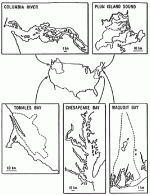Recent Activities
The third annual Land-Margin Ecosystem Research (LMER) Scientists Meeting was held at the Marine Biological Laboratory. Woods Hole. Massachusetts, in November 1992. Forty-seven participants attended from the five LMER projects, plus representatives from the Coastal Ocean Program of NOAA, the National Science Foundation (NSF), the Smithsonian Environmental Research Center, NSF’s Coastal Ocean Process Program, and the Waquoit Bay National Estuarine Research Reserve.
The agenda included talks on the Coastal Ocean Program and on remote sensing in coastal waters. Workshops focused on the identification of future cooperative and comparative research among the LMER projects, with themes of: vertical coupling, the exchange of nutrients and organic matter between benthic and pelagic systems; land-water coupling, the discharge of water, nutrients, organic matter, and sediments from the land into coastal waters; geographic information systems (GIS), the use of GIS for environmental information storage and analysis as well as for the input of spatial data to models; and biological-physical modeling, the incorporation of biological processes into physical models of water movement.
Program Goals and the Comparative Approach
The comparative approach to ecological research is an efficient way to predict responses of all coastal systems. The LMER Program is first striving for a thorough understanding of the patterns and processes common to the LMER sites and other well-studied systems such as Narragansett Bay. The longer-term goal is to incorporate the knowledge of processes and controls into predictions of the results of future changes, including land use and climate change, on coastal ecosystems in many geographic regions. One type of comparative study is a regression of characteristics of various landscapes on rates or processes. For example, it may be possible to build up a regression equation that will relate population density in areas of different land use to nutrient discharge into coastal waters.
Another type of comparative study under consideration involves taking measurements of one process along an environmental gradient in very different ecosystems. This is a good way to gain understanding of the controls of a particular process so that a prediction may be made of the activity or rate of the process under changed environmental conditions. Different parts of Chesapeake Bay, for example, have different patterns and rates of ammonium flux from the sediments. A future study may be carried out to relate this to variables such as the deposition of algae from the spring bloom.
LMER Coordination Office
The National Science Foundation has funded an LMER coordination office at the Ecosystems Center, Marine Biological Laboratory, Woods Hole, MA 02543, staffed by Executive Assistant Debbie Scanlon, 508-548-3705, extension 496. John Hobbie (Arctic Tundra LTER) is serving as coordinating committee chair and Chris D’Elia, University of Maryland, as co-chair. An LMER Personnel Directory and a report on the November 1992 Annual LMER All Scientists Meeting are now available. ‘

 Enlarge this image
Enlarge this image